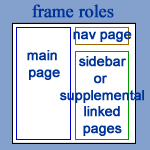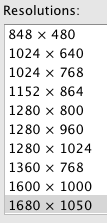Focus Management
 Digital pages can have advantages that paper books cannot provide. This design makes reading easier, more efficient and more powerful in carrying out basic and advanced thinking and reading functions. This includes: managing asides, checking sources, focusing, and extending questions. This type of Web page design is called a frameset. It glues multiple Web pages together in one window as in the graphic example on the left. This composition is showing three frames. Think of it as a kind of three ring circus with a different act in each ring. The left side shows the chapter's central essay. The right side is used to display the "asides" and extensions. The top right frame can be thought of as a focus manager.
Digital pages can have advantages that paper books cannot provide. This design makes reading easier, more efficient and more powerful in carrying out basic and advanced thinking and reading functions. This includes: managing asides, checking sources, focusing, and extending questions. This type of Web page design is called a frameset. It glues multiple Web pages together in one window as in the graphic example on the left. This composition is showing three frames. Think of it as a kind of three ring circus with a different act in each ring. The left side shows the chapter's central essay. The right side is used to display the "asides" and extensions. The top right frame can be thought of as a focus manager.
 The graphic on the right labels the roles. One form of aside is the Web link. Clicking any links in the essay on the left will cause them to appear in this large frame space on the right. Asides are also the citations or references. The ^ symbol after a reference will also cause that reference or citation to appear at the top of the frame on the right, along with any live Web link to that reference if available. If a link in the bibliography is clicked, that reference will appear in its own window, a new window.
The graphic on the right labels the roles. One form of aside is the Web link. Clicking any links in the essay on the left will cause them to appear in this large frame space on the right. Asides are also the citations or references. The ^ symbol after a reference will also cause that reference or citation to appear at the top of the frame on the right, along with any live Web link to that reference if available. If a link in the bibliography is clicked, that reference will appear in its own window, a new window.
The links in the top right frame control whether there is a composition in the left or right frames. Note the links to "clear left" and "clear right". That is, one way to increase focus is to clear one side or the other depending on which side has become distracting. Another option is to click "no frames" and you'll be back to the main reading as one page in the window. With just one window frame, any clicked link will open over the top of the essay, pages which can then be re-sized, moved or deleted. A further option is to always keep the left frame and main reading in view, showing or clearing the right side as needed. Some readers find it useful to keep both frames active at the same time.
More effective readers constantly question as they read. The Search links in top window will open search tools on the right for immediately exploring answers to questions as they occur while the reading passage that stimulated the search stays in view on the left.
Viewing with the Internet Explorer and Firefox and some other browsers will enable a re-size frame command on the vertical line between the two frames. The "show left" command will always return to the top of the essay in the left frame.
 Finding the right display and font sizes can also help focus. The larger the screen display and the greater the screen resolution, the easier and more functional the multi-frame format becomes. The left frame of the frameset is set to a fixed width of approximately 55 characters, assuming a standard Times font and use of the default font size. The right side can be stretched further to the right to whatever the maximum size of the screen allows. At any point the Web browser's ctrl + and ctrl - keys can be used to increase or decrease the font size.
Finding the right display and font sizes can also help focus. The larger the screen display and the greater the screen resolution, the easier and more functional the multi-frame format becomes. The left frame of the frameset is set to a fixed width of approximately 55 characters, assuming a standard Times font and use of the default font size. The right side can be stretched further to the right to whatever the maximum size of the screen allows. At any point the Web browser's ctrl + and ctrl - keys can be used to increase or decrease the font size.
The size and usability of the right frame depends on how many pixels wide the computer display screen can be set. Changing the pixel width is an easy-to-change quantity. It requires going to the control panel (Mac-"system preferences") and selecting the screen or display button. Options on that window will let users pick a range of numbers up to the maximum size of the display screen's hardware. When presented with a series of pixel numbers as in the list on the right of this paragraph, the first number is the horizontal number or screen width. The left frame has a fixed width, so the bigger the horizontal pixel width, the wider the right frame can be stretched.
In addition to the reading options provided by the design of these chapters, current Web browsers make it possible to right-click to a menu on any Web link or in the white space of any frame page and open the page on top of the existing page. Other options will vary depending on the browser.
Experiment with the different links in the top right frame. Try them all, then return to reading to use them as needed.
 Digital pages can have advantages that paper books cannot provide. This design makes reading easier, more efficient and more powerful in carrying out basic and advanced thinking and reading functions. This includes: managing asides, checking sources, focusing, and extending questions. This type of Web page design is called a frameset. It glues multiple Web pages together in one window as in the graphic example on the left. This composition is showing three frames. Think of it as a kind of three ring circus with a different act in each ring. The left side shows the chapter's central essay. The right side is used to display the "asides" and extensions. The top right frame can be thought of as a focus manager.
Digital pages can have advantages that paper books cannot provide. This design makes reading easier, more efficient and more powerful in carrying out basic and advanced thinking and reading functions. This includes: managing asides, checking sources, focusing, and extending questions. This type of Web page design is called a frameset. It glues multiple Web pages together in one window as in the graphic example on the left. This composition is showing three frames. Think of it as a kind of three ring circus with a different act in each ring. The left side shows the chapter's central essay. The right side is used to display the "asides" and extensions. The top right frame can be thought of as a focus manager.  The graphic on the right labels the roles. One form of aside is the Web link. Clicking any links in the essay on the left will cause them to appear in this large frame space on the right. Asides are also the citations or references. The ^ symbol after a reference will also cause that reference or citation to appear at the top of the frame on the right, along with any live Web link to that reference if available. If a link in the bibliography is clicked, that reference will appear in its own window, a new window.
The graphic on the right labels the roles. One form of aside is the Web link. Clicking any links in the essay on the left will cause them to appear in this large frame space on the right. Asides are also the citations or references. The ^ symbol after a reference will also cause that reference or citation to appear at the top of the frame on the right, along with any live Web link to that reference if available. If a link in the bibliography is clicked, that reference will appear in its own window, a new window.